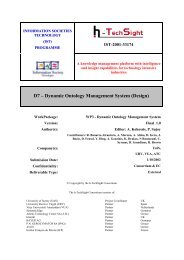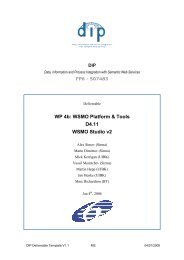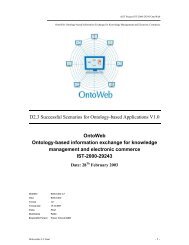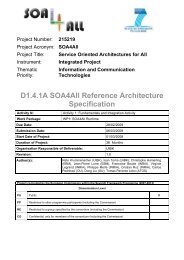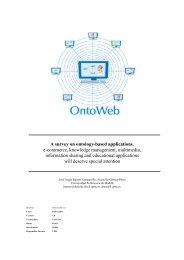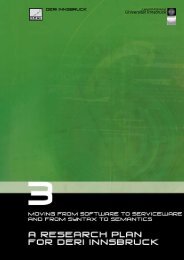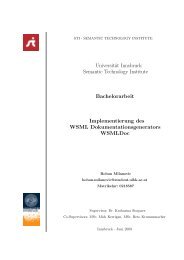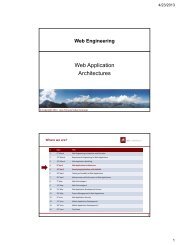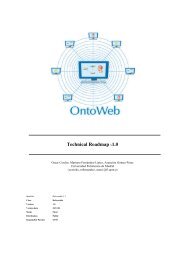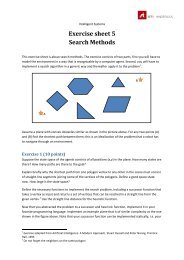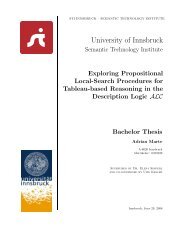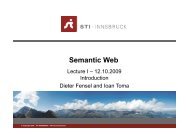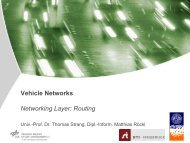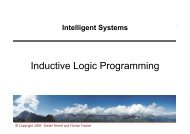Vehicle Networks CAN-based Higher Layer Protocols - STI Innsbruck
Vehicle Networks CAN-based Higher Layer Protocols - STI Innsbruck
Vehicle Networks CAN-based Higher Layer Protocols - STI Innsbruck
You also want an ePaper? Increase the reach of your titles
YUMPU automatically turns print PDFs into web optimized ePapers that Google loves.
<strong>Vehicle</strong> <strong>Networks</strong><br />
<strong>CAN</strong>-<strong>based</strong> <strong>Higher</strong> <strong>Layer</strong> <strong>Protocols</strong><br />
Univ.-Prof. Dr. Thomas Strang, Dipl.-Inform. Matthias Röckl
Lecture <strong>Vehicle</strong> <strong>Networks</strong>, Thomas Strang and Matthias Röckl, WS 2008/2009<br />
Outline<br />
Introduction<br />
General-purpose HLPs<br />
ISO TP<br />
TP2.0<br />
Special-purpose HLPs<br />
<strong>Vehicle</strong>-Operational Purposes:<br />
<strong>CAN</strong>open<br />
SAE J1939<br />
Diagnostics Purposes:<br />
ISO 15765-3 (KWP2000/<strong>CAN</strong>)<br />
Unified Diagnostic Services<br />
On-Board Diagnostics
Lecture <strong>Vehicle</strong> <strong>Networks</strong>, Thomas Strang and Matthias Röckl, WS 2008/2009<br />
Introduction<br />
“Pure <strong>CAN</strong>” provides fast, prioritized, reliable, broadcast message transmission<br />
with sophisticated error detection and error handling<br />
Pure <strong>CAN</strong> can fulfill all requirements of small closed systems<br />
Pure <strong>CAN</strong> cannot satisfy the requirements that have to be fulfilled within<br />
large, extendable, interconnected networks from different manufacturers<br />
� <strong>Higher</strong> <strong>Layer</strong> <strong>Protocols</strong> (HLP) required that enable the interconnection of<br />
these networks<br />
Inter-manufacturer connection is of major importance for all kinds of utility<br />
vehicles:<br />
Trucks<br />
Tractors<br />
Snowcats<br />
Extension:<br />
Harvesters<br />
Foresters<br />
Cranes<br />
Fixed attached components: blue lights, information systems, taximeter<br />
Dynamic attached components: trailers, seeders, dozer blades<br />
Highly dynamic attaches components: Fleet management system
Lecture <strong>Vehicle</strong> <strong>Networks</strong>, Thomas Strang and Matthias Röckl, WS 2008/2009<br />
Introduction<br />
Functions that have to be fulfilled by HLPs:<br />
Definition of common message identifiers, their meaning, format and<br />
respective data types to enable interoperability<br />
Flow control<br />
Transportation of messages > 8 bytes<br />
Node addressing to address a specific device<br />
Networking via gateways<br />
Network management:<br />
Startup, maintenance and shutdown behavior<br />
Status reporting, diagnosis<br />
Application Application Application<br />
Application<br />
<strong>CAN</strong><br />
Low Speed<br />
Interconnecting <strong>Higher</strong> <strong>Layer</strong> Protocol<br />
<strong>CAN</strong><br />
Low Speed<br />
<strong>CAN</strong><br />
High Speed<br />
<strong>CAN</strong><br />
High Speed<br />
Other<br />
<strong>Protocols</strong>
Lecture <strong>Vehicle</strong> <strong>Networks</strong>, Thomas Strang and Matthias Röckl, WS 2008/2009<br />
Introduction<br />
<strong>CAN</strong> in ISO/OSI Reference Model<br />
No. of<br />
layer<br />
ISO/OSI ref model <strong>CAN</strong> protocol specification<br />
7 Application Application specific<br />
6 Presentation<br />
5 Session<br />
4 Transport<br />
3 Network<br />
2 Data Link<br />
1 Physical<br />
Optional:<br />
<strong>Higher</strong> <strong>Layer</strong> <strong>Protocols</strong> (HLP)<br />
<strong>CAN</strong> protocol<br />
(with free choice of medium)
Lecture <strong>Vehicle</strong> <strong>Networks</strong>, Thomas Strang and Matthias Röckl, WS 2008/2009<br />
Introduction<br />
Protocol messaging<br />
<strong>Layer</strong> N<br />
<strong>Layer</strong> N-1<br />
Protocol Data Unit (PDU) of layer N becomes Service Data Unit (SDU)<br />
of layer N-1<br />
(N-1)-SDU extended with Protocol Control Information (PCI) and Footer<br />
becomes (N-1)-PDU<br />
Terminology<br />
<strong>Layer</strong> 1 PDU: bits<br />
<strong>Layer</strong> 2 PDU: frame<br />
<strong>Layer</strong> 3 PDU: packet<br />
<strong>Layer</strong> 4 PDU: segment<br />
(N)-PDU<br />
PCI Payload Footer<br />
PCI SDU<br />
Footer<br />
(N-1)-PDU<br />
RECAP
Lecture <strong>Vehicle</strong> <strong>Networks</strong>, Thomas Strang and Matthias Röckl, WS 2008/2009<br />
<strong>Layer</strong><br />
N<br />
<strong>Layer</strong><br />
N-1<br />
Introduction<br />
Protocol service primitives<br />
Service Access Points (SAP) provide services to upper and lower layers<br />
SAP to layer (N-1)<br />
Request<br />
Confirmation<br />
SAP to layer (N)<br />
Response<br />
Indication<br />
End system A Network End system B<br />
(N)-Service User<br />
SAP SAP<br />
(N-1)-Service Provider<br />
Protocol<br />
(PDU)<br />
(N)-Service User<br />
(1) Request (4) Confirmation (3) Response (2) Indication<br />
(N-1)-Service Provider<br />
RECAP
Lecture <strong>Vehicle</strong> <strong>Networks</strong>, Thomas Strang and Matthias Röckl, WS 2008/2009<br />
Introduction<br />
Network <strong>Layer</strong><br />
Transmission of packets over multiple intermediate hops<br />
<strong>Protocols</strong>: IPv4, IPv6, ICMP, IGMP<br />
Main functions:<br />
Global addressing<br />
Routing, e.g.:<br />
Flooding<br />
Link State Routing<br />
Distance Vector Routing<br />
Hierarchical Routing<br />
Fragmentation<br />
Quality of Service<br />
RECAP
Lecture <strong>Vehicle</strong> <strong>Networks</strong>, Thomas Strang and Matthias Röckl, WS 2008/2009<br />
Introduction<br />
Transport <strong>Layer</strong><br />
Data exchange over a logical connection between end-to-end systems<br />
<strong>Protocols</strong>: TCP, UDP, DCCP, SCTP<br />
Main functions:<br />
Reliability management:<br />
Reliable communication (e.g. TCP by acknowledgements)<br />
Unreliable communication (e.g. UDP)<br />
Segmentation with (un)ordered delivery<br />
Flow control: Overload at receivers<br />
Congestion control: Overload of the network<br />
Connection management:<br />
Connection-oriented (e.g. TCP)<br />
Connectionless (e.g. UDP)<br />
Error Control<br />
Multiplexing of concurrent services<br />
RECAP
Lecture <strong>Vehicle</strong> <strong>Networks</strong>, Thomas Strang and Matthias Röckl, WS 2008/2009<br />
General-purpose HLPs<br />
ISO-TP
Lecture <strong>Vehicle</strong> <strong>Networks</strong>, Thomas Strang and Matthias Röckl, WS 2008/2009<br />
ISO-TP<br />
Overview<br />
ISO-TP = ISO Transport Protocol<br />
Designed to run existing diagnostics protocols (ISO 14230) on <strong>CAN</strong><br />
Unreliable connection-oriented transport protocol enabling:<br />
Segmentation (transmission of up to 4095 bytes)<br />
Flow Control<br />
Broadcast and unicast addressing<br />
Uses <strong>CAN</strong> on Data Link layer<br />
Standardized under ISO 15765-2<br />
E.g. used with diagnostics protocols KWP2000 and UDS
Lecture <strong>Vehicle</strong> <strong>Networks</strong>, Thomas Strang and Matthias Röckl, WS 2008/2009<br />
ISO-TP<br />
Frames<br />
Frame Types:<br />
Single Frame:<br />
0x0 Data Length 0..7 Data Bytes<br />
Standard frame for unsegmented data<br />
First Frame:<br />
0x1 Data Length Data Length 0..6 Data Bytes<br />
Initial frame in a sequence of frames<br />
Consecutive Frame:<br />
Subsequent frame in the sequence (SN modulo 24 0x2 Seq Number 0..7 Data Bytes<br />
)<br />
Flow Control Frame:<br />
0x3 Flow Status Block Size Separation Time<br />
Response of the receiver specifying min. timing and max. buffer size (=block size) for<br />
consecutive frames<br />
In case of error (timeout or wrong<br />
sequence number) application layer<br />
is informed but not sender of the<br />
message<br />
� no inherent reliability,<br />
application layer has to handle errors<br />
4 bit 4 bit 8 bit 8 bit<br />
0-127ms<br />
0-127ms<br />
0-127ms<br />
…<br />
…
Lecture <strong>Vehicle</strong> <strong>Networks</strong>, Thomas Strang and Matthias Röckl, WS 2008/2009<br />
ISO-TP<br />
Addressing<br />
Flow control requires unicast communication<br />
Addresses have to be predefined and statically assigned<br />
Addressing schemes:<br />
Normal Addressing:<br />
Source and destination address are encoded in <strong>CAN</strong> identifier<br />
Extended Addressing (for gateways):<br />
Additional Transport-PCI Byte (= first byte of <strong>CAN</strong> payload) with<br />
gateway address<br />
� <strong>CAN</strong> payload reduced to 0..6 bytes
Lecture <strong>Vehicle</strong> <strong>Networks</strong>, Thomas Strang and Matthias Röckl, WS 2008/2009<br />
General-purpose HLPs<br />
TP2.0
Lecture <strong>Vehicle</strong> <strong>Networks</strong>, Thomas Strang and Matthias Röckl, WS 2008/2009<br />
TP2.0<br />
Overview<br />
Designed to allow existing diagnostics protocols on <strong>CAN</strong>2.0A<br />
Mainly used by Volkswagen Group<br />
Connection-oriented transport protocol enabling:<br />
Segmentation of arbitrary size<br />
Flow control with handshake<br />
Dynamic assignment of <strong>CAN</strong> identifier per channel (vs. static<br />
assignment of <strong>CAN</strong> identifiers in ISO-TP)<br />
Automatic recovery after timeout<br />
Addressing:<br />
Unicast<br />
Multicast, e.g. all ECUs on the powertrain<br />
Broadcast
Lecture <strong>Vehicle</strong> <strong>Networks</strong>, Thomas Strang and Matthias Röckl, WS 2008/2009<br />
TP2.0<br />
Broadcast communication<br />
Allows usage of gateways (specified by Logical Address)<br />
Broadcast messages with and without required response<br />
<strong>CAN</strong><br />
Identifier<br />
Opening ID Logical<br />
Address<br />
Opcode SID<br />
Service ID<br />
Request 0x23<br />
Response 0x24<br />
<strong>CAN</strong><br />
Payload<br />
Para<br />
meter<br />
Para<br />
meter
Lecture <strong>Vehicle</strong> <strong>Networks</strong>, Thomas Strang and Matthias Röckl, WS 2008/2009<br />
TP2.0<br />
Connection-oriented unicast communication<br />
Connection setup request/response message:<br />
<strong>CAN</strong> Identifier <strong>CAN</strong> Payload<br />
Opening ID Address Opcode RX ID TX ID<br />
Data message:<br />
Destination ID<br />
Request 0xCO<br />
Positive Response 0xD0<br />
Negative Response 0xD6-0xD8<br />
Opening ID Opcode 1..7 Data<br />
Opening ID Opcode ACK<br />
Connection shutdown message:<br />
Opening ID Opcode<br />
Connection Test 0xA3<br />
Positive Response 0xA4<br />
Negative Response 0xA8<br />
APP<br />
Type<br />
Sender ID ID of application<br />
e.g. 0x01 Diagnostics<br />
Includes Sequence Number, Receive Ready (for Flow Control), etc.
Lecture <strong>Vehicle</strong> <strong>Networks</strong>, Thomas Strang and Matthias Röckl, WS 2008/2009<br />
TP2.0<br />
Message sequence<br />
1. Channel Setup<br />
2. Data Exchange<br />
Block-wise data transmission<br />
Cumulative acknowledgements<br />
3. Channel Shutdown<br />
…
Lecture <strong>Vehicle</strong> <strong>Networks</strong>, Thomas Strang and Matthias Röckl, WS 2008/2009<br />
Special-purpose HLPs<br />
<strong>CAN</strong>open
Lecture <strong>Vehicle</strong> <strong>Networks</strong>, Thomas Strang and Matthias Röckl, WS 2008/2009<br />
<strong>CAN</strong>open<br />
Overview<br />
Developed by <strong>CAN</strong> in Automation (CiA) since 1995<br />
Originally developed for motion-oriented machine control networks,<br />
by now it is also used to network:<br />
medical electronics, automotive-, industrial- and rail-vehicles, laboratory<br />
automation systems,<br />
building automation systems,<br />
embedded networks such as passenger information systems, gambling<br />
machines and professional coffee machines,<br />
vehicle add-ons (blue lights, taximeter, etc.)<br />
Standardized in 2002 under EN 50325-4<br />
Features:<br />
<strong>CAN</strong> 2.0A on Data Link layer (optional <strong>CAN</strong> 2.0B)<br />
Network auto-configuration<br />
Access to all device parameters<br />
Device synchronization<br />
Cyclic and event-driven data transfer<br />
Synchronous reading or setting of inputs, outputs or parameters
Lecture <strong>Vehicle</strong> <strong>Networks</strong>, Thomas Strang and Matthias Röckl, WS 2008/2009<br />
<strong>CAN</strong>open<br />
Overview<br />
Three parts:<br />
Application <strong>Layer</strong><br />
Object Dictionary<br />
Communication Profile<br />
Based on: Zeltwanger 2007, <strong>CAN</strong>open<br />
Object Dictionary<br />
Communication<br />
Profile Area<br />
Manufacturer<br />
Application<br />
Specific Profile Area<br />
Standardized Device<br />
Profile Area<br />
Network Variables<br />
Area<br />
Index Value<br />
1000-<br />
1FFF<br />
2000-<br />
5FFF<br />
6000-<br />
9FFF<br />
A000-<br />
AFFF<br />
Communication Profile<br />
SDO PDO …
Lecture <strong>Vehicle</strong> <strong>Networks</strong>, Thomas Strang and Matthias Röckl, WS 2008/2009<br />
<strong>CAN</strong>open<br />
Object Dictionary and Profiles<br />
Every <strong>CAN</strong>open device has a standardized device specification, the Object<br />
Dictionary (OD)<br />
It includes general objects (ID, manufacturer, etc.) and status objects<br />
(temperature, speed, etc.)<br />
Semantics of the OD-objects are defined in the Electronic Data Sheet<br />
(EDS)<br />
Objects are addressed by 16-bit index + 8-bit subindex<br />
1000-1FFF: Communication profile area (CiA DS-301)<br />
2000-5FFF: Manufacturer-specific profile area<br />
6000-9FFF: Standardized device profile area (e.g. CiA DS-401)<br />
A000-AFFF: Network variables (NWV)<br />
<strong>CAN</strong>open defines:<br />
Communication profiles: definition of fundamental communication<br />
mechanisms<br />
Device profiles: unambiguous definition of manufacturer-independent ODparameters<br />
describing the device and its network behavior (i.e. input/output<br />
modules, drives, encoders, etc.)<br />
� Devices become interoperable and interchangeable between<br />
manufacturers
Lecture <strong>Vehicle</strong> <strong>Networks</strong>, Thomas Strang and Matthias Röckl, WS 2008/2009<br />
<strong>CAN</strong>open<br />
Communication Profile<br />
Process Data Objects (PDO): Transport of real-time data (=operational data)<br />
Service Data Objects (SDO): Read and write OD entries (=system parameters)<br />
Special Object Messages:<br />
Synchronization (SYNC)<br />
Cyclic time synchronization<br />
Time Stamp (TIME)<br />
Adjustment of global network time<br />
Emergency Object (EMCY)<br />
Indicate device internal errors<br />
Administrative Messages:<br />
Network Management (NMT)<br />
Node state monitoring<br />
Error Control:<br />
Cyclic heartbeat,<br />
Node/Life guarding<br />
PDO<br />
Process Data Object<br />
• Real-time data<br />
• High priority<br />
• Max. 8 Bytes<br />
• Broadcast communication<br />
• “Pure” <strong>CAN</strong><br />
• No confirmation<br />
Communication<br />
Profile<br />
SDO<br />
Service Data Object<br />
• System parameters<br />
• Low priority<br />
• Data aggregation (>8 Bytes)<br />
• Unicast communication<br />
• Data addressing by index<br />
• Confirmed services
Lecture <strong>Vehicle</strong> <strong>Networks</strong>, Thomas Strang and Matthias Röckl, WS 2008/2009<br />
<strong>CAN</strong>open<br />
Device and Application Profiles (extract)<br />
CiA 301: <strong>CAN</strong>open application layer and communication profile<br />
CiA 401: Device profile for generic I/O modules<br />
CiA 402: Device profile for drives and motion control (servo controller, stepper<br />
motor controller, frequency inverter)<br />
CiA 404: Device profile for measuring devices and closed-loop controllers<br />
CiA 406: Device profile for encoders (rotating and linear)<br />
CiA 413: Set of device profiles for truck gateways<br />
CiA 415: Application profile for road construction machine sensors<br />
CiA 418: Device profile for battery module<br />
CiA 419: Device profile for battery charger<br />
CiA 422: Application profile for municipal vehicles (e.g. garbage trucks)<br />
CiA 423: Application profile for power drive systems (e.g. diesel engine)<br />
CiA 424: Application profile for rail vehicle door control systems<br />
CiA 447: Application profile for special-purpose car add-on devices
Lecture <strong>Vehicle</strong> <strong>Networks</strong>, Thomas Strang and Matthias Röckl, WS 2008/2009<br />
<strong>CAN</strong>open<br />
CiA DS-447 Car add-on devices<br />
Attachment of add-on devices, such as blue light, siren, taximeter, etc.<br />
Standardization finished in 2008
Lecture <strong>Vehicle</strong> <strong>Networks</strong>, Thomas Strang and Matthias Röckl, WS 2008/2009<br />
<strong>CAN</strong>open<br />
CiA DS-413 Device profiles for truck gateways
Lecture <strong>Vehicle</strong> <strong>Networks</strong>, Thomas Strang and Matthias Röckl, WS 2008/2009<br />
<strong>CAN</strong>open<br />
Source: Zeltwanger 2005: J1939-<strong>based</strong> application profiles<br />
ISO 11783 (ISOBUS) for agricultural and municipal vehicles, <strong>based</strong> on J1939 and NMEA-2000
Lecture <strong>Vehicle</strong> <strong>Networks</strong>, Thomas Strang and Matthias Röckl, WS 2008/2009<br />
Special-purpose HLPs<br />
SAE J1939
Lecture <strong>Vehicle</strong> <strong>Networks</strong>, Thomas Strang and Matthias Röckl, WS 2008/2009<br />
SAE J1939<br />
Specified by Society of Automotive Engineers (SAE) heavy trucks and bus<br />
division<br />
The SAE J1939 set of profiles is <strong>based</strong> on the <strong>CAN</strong> data link layer (ISO 11898-1)<br />
using the extended frame format (<strong>CAN</strong>2.0B) with 29-bit identifier<br />
Features<br />
Unicast and broadcast communication<br />
Network management<br />
Transport protocol functions: data segmentation, flow control<br />
Definition of parameter groups<br />
Support of real-time close loop control<br />
Applications<br />
Light to heavy trucks<br />
Agriculture equipment<br />
e.g. tractors, harvester, etc.<br />
Engines for public work
Lecture <strong>Vehicle</strong> <strong>Networks</strong>, Thomas Strang and Matthias Röckl, WS 2008/2009<br />
SAE J1939<br />
Standards<br />
SAE J1939-71 Truck and bus<br />
power-train network<br />
Defines all parameters as well as<br />
assembled messages called<br />
parameter groups<br />
SAE J1939-31 Network layer<br />
Defines repeaters, routers, gateways and bridges<br />
SAE J1939-73 Application<br />
layer diagnostics<br />
Defines diagnostic messages<br />
SAE J1939-21 Data link layer<br />
Defines commonly used messages such as Request, Acknowledgement and<br />
Transport Protocol<br />
SAE J1939-11 Physical layer<br />
Physical layer <strong>based</strong> on ISO 11898-2 at 250 kbit/s with up to 30 devices and a<br />
maximum of 40 m bus length (twisted shielded pair)<br />
SAE J1939-81 Network management<br />
Defines message sequences for initialization<br />
and constraints on the use of addresses (e.g.<br />
address claiming)
Lecture <strong>Vehicle</strong> <strong>Networks</strong>, Thomas Strang and Matthias Röckl, WS 2008/2009<br />
SAE J1939<br />
Message Format<br />
Priority<br />
3<br />
<strong>CAN</strong> 29-bit-Identifier Structure<br />
Reser<br />
ved<br />
1<br />
Data<br />
Page<br />
1<br />
Parameter Group Number (PGN)<br />
18<br />
PDU Format<br />
8<br />
PDU Specific<br />
Priority: Priority during the arbitration phase (lower value = higher priority)<br />
Reserved: Reserved for future usage (always 0)<br />
Data Page selector: Expands parameter groups (for future usage)<br />
PDU Format:<br />
Global PGNs for broadcast parameter groups<br />
PDU Format >= 0xF0 = 240 10<br />
PDU Specific: Group Extension (further PDU type specification)<br />
Specific PGNs for unicast parameter groups<br />
PDU Format
Lecture <strong>Vehicle</strong> <strong>Networks</strong>, Thomas Strang and Matthias Röckl, WS 2008/2009<br />
SAE J1939<br />
Example<br />
Engine Temperature message: Broadcast transmission with 1 Hz<br />
S<br />
O F<br />
Priority<br />
6<br />
Arbitration<br />
Field<br />
Res<br />
0<br />
DP<br />
0<br />
Control<br />
Field<br />
PDU Format<br />
254=0xFE<br />
<strong>CAN</strong> 2.0B Frame<br />
Data Field CRC<br />
PDU Specific<br />
238=0xEE<br />
Source Address<br />
???<br />
Coolant<br />
Temperature<br />
Fuel<br />
Temperature<br />
Engine Oil<br />
Temperature<br />
Turbo Oil<br />
Temperature<br />
Engine Intercooler<br />
Temp.<br />
Not defined<br />
8 8 16 16 8 8<br />
Torque/Speed Control message: Unicast transmission<br />
to Engine (=00) with 100 Hz<br />
to Engine-Retarder(=15) with 20 Hz<br />
Priority<br />
3<br />
Res<br />
0<br />
DP<br />
0<br />
PDU Format<br />
0<br />
PDU Specific<br />
15 (= Engine-Retarder)<br />
Source Address<br />
11 (= ABS/TC)<br />
A<br />
C K<br />
End of<br />
Frame<br />
Control Bits<br />
Requested Speed /<br />
Speed Limit<br />
Requested Torque /<br />
Torque Limit<br />
Not defined<br />
8 16 8 32
Lecture <strong>Vehicle</strong> <strong>Networks</strong>, Thomas Strang and Matthias Röckl, WS 2008/2009<br />
SAE J1939<br />
Transport <strong>Layer</strong><br />
The Transport Protocol specifies the breaking up of large amounts of data into<br />
multiple <strong>CAN</strong>-sized frames, along with adequate communication and timing to<br />
support effective frame transmission between nodes<br />
Two types:<br />
Broadcast Announcement Message (BAM)<br />
Broadcast communication<br />
Connection-less (e.g. no handshake)<br />
Unreliable<br />
No flow control<br />
Connection Mode Data Transfer (CMDT)<br />
Unicast communication<br />
Connection-oriented (2-way handshake)<br />
Reliability by cumulative ACKs<br />
Flow control by windowing<br />
…<br />
…<br />
…
Lecture <strong>Vehicle</strong> <strong>Networks</strong>, Thomas Strang and Matthias Röckl, WS 2008/2009<br />
SAE J1939<br />
Addressing<br />
Address:<br />
Unique identity within a session<br />
Every device requires a unique address (0-253)<br />
254: zero address<br />
255: broadcast address<br />
Included in every message<br />
Can change during re-configuration<br />
Name:<br />
Probably unique identifier within the network<br />
Provides functional identification of ECUs<br />
Used to arbitrate in the case of an address selection conflict<br />
Name
Lecture <strong>Vehicle</strong> <strong>Networks</strong>, Thomas Strang and Matthias Röckl, WS 2008/2009<br />
SAE J1939<br />
Network management<br />
Dynamic address allocation<br />
(address claiming)<br />
Address conflict detection<br />
Address conflict resolution
Lecture <strong>Vehicle</strong> <strong>Networks</strong>, Thomas Strang and Matthias Röckl, WS 2008/2009<br />
SAE J1939<br />
Application<br />
Source: Vector 2006, <strong>CAN</strong> und J1939<br />
Unter extremen Einsatzbedingungen<br />
Source: CLAAS 2005, Diagnose bei CLAAS
Lecture <strong>Vehicle</strong> <strong>Networks</strong>, Thomas Strang and Matthias Röckl, WS 2008/2009<br />
SAE J1939<br />
Fleet Management System (FMS)<br />
Supervise a whole fleet - consisting of vehicles from different manufacturers - over<br />
the Internet<br />
Developed by the 6 major European truck manufacturers Daimler, MAN, Scania,<br />
DAF, IVECO, Volvo/Renault<br />
Based on J1939<br />
<strong>Vehicle</strong> data shall be available for third parties but internal vehicle busses shall be<br />
untouched<br />
Secure and legal solution for the remote download of data e.g. from the digital<br />
tachograph<br />
Following<br />
traffic<br />
Individual re-routing<br />
because of<br />
congestion<br />
control<br />
GPS Positioning<br />
Congestion<br />
„Floating“ cars report<br />
position + velocity + x
Lecture <strong>Vehicle</strong> <strong>Networks</strong>, Thomas Strang and Matthias Röckl, WS 2008/2009<br />
Special-purpose HLPs<br />
Diagnostics
Lecture <strong>Vehicle</strong> <strong>Networks</strong>, Thomas Strang and Matthias Röckl, WS 2008/2009<br />
Diagnostics<br />
Interchange of digital information between an on-board ECU and a off-board<br />
diagnostic tester to facilitate inspection, test, diagnostics and configuration<br />
<strong>Layer</strong><br />
7-5<br />
<strong>Layer</strong><br />
4-3<br />
<strong>Layer</strong><br />
2-0<br />
Manufacturer enhanced diagnostics Legislated diagnostics<br />
Unified Diagnostic Services<br />
ISO 14229<br />
ISO 14230-3<br />
ISO 14230-2<br />
K-Line<br />
ISO 15765-3<br />
Diagnostics on <strong>CAN</strong><br />
ISO 15765-2<br />
ISO 11898<br />
<strong>CAN</strong><br />
TP2.0<br />
On-Board Diagnostics (OBD)<br />
ISO 15031<br />
ISO 15031-5<br />
K-Line <strong>CAN</strong> J1850<br />
Based on: Zimmermann, Schmidgall 2007: Bussysteme in der Fahrzeugtechnik<br />
Mandatory<br />
after 2008<br />
in US
Lecture <strong>Vehicle</strong> <strong>Networks</strong>, Thomas Strang and Matthias Röckl, WS 2008/2009<br />
Diagnostics<br />
ISO 15765-3 Diagnostics on <strong>CAN</strong><br />
Diagnostics on <strong>CAN</strong> standardized in ISO 15765-3 in 2004<br />
Enables interoperability between off-board diagnostic tester and onboard<br />
ECU<br />
ISO 15765-3 is <strong>based</strong> on the Keyword Protocol 2000 (KWP2000)<br />
protocol<br />
Client-Server with simple request-response communication<br />
Off-board<br />
Diagnostic<br />
Tester<br />
<strong>Vehicle</strong><br />
Gateway<br />
ECU<br />
ECU<br />
ECU<br />
ECU
Lecture <strong>Vehicle</strong> <strong>Networks</strong>, Thomas Strang and Matthias Röckl, WS 2008/2009<br />
Diagnostics<br />
ISO 15765-3 Diagnostics on <strong>CAN</strong><br />
Client-Server communication:<br />
Client (=diagnostic tester) initiates request and waits for<br />
confirmation<br />
Server (=ECU) receives indication and sends response<br />
Services<br />
Diagnostic Management: Control of diagnostic sessions<br />
Network <strong>Layer</strong> Protocol Control<br />
Data Transmission: Read from and write to ECUs<br />
Stored Data Transmission: Read Diagnostic Trouble Codes (DTC)<br />
Input/Output Control: Control of ECU I/O<br />
Remote Activation of Routines: ECU program startup<br />
Upload/Download: ECU Flashing
Lecture <strong>Vehicle</strong> <strong>Networks</strong>, Thomas Strang and Matthias Röckl, WS 2008/2009<br />
Diagnostics<br />
ISO 15765-3 Diagnostics on <strong>CAN</strong><br />
Message formats:<br />
Service ID<br />
SID<br />
Service Request<br />
Request Parameters<br />
Positive Response<br />
SID | 0x40 Response Parameters<br />
Negative Response<br />
Error ID SID<br />
Error Code
Lecture <strong>Vehicle</strong> <strong>Networks</strong>, Thomas Strang and Matthias Röckl, WS 2008/2009<br />
Diagnostics<br />
Unified Diagnostic Services<br />
Unified Diagnostics Services (UDS) standardized by ISO 14229<br />
Advancement of Diagnostics on <strong>CAN</strong> for general usage<br />
Whereas ISO 15765-3 relies on <strong>CAN</strong>, UDS is independent of lower layer<br />
protocols<br />
Technically UDS is almost identical to Diagnostics on <strong>CAN</strong>,<br />
advancements are mainly the restructuring of SIDs and unification<br />
UDS also defines, as one of the first protocols, a security layer in order<br />
to encrypt data<br />
APP APP<br />
Security<br />
<strong>Layer</strong><br />
Security<br />
<strong>Layer</strong><br />
UDS UDS<br />
<strong>CAN</strong> <strong>CAN</strong>
Lecture <strong>Vehicle</strong> <strong>Networks</strong>, Thomas Strang and Matthias Röckl, WS 2008/2009<br />
Diagnostics<br />
On-Board Diagnostics<br />
Self-diagnostic and reporting capability of modern vehicles<br />
Guarantees standardized access to vehicle information for:<br />
fault diagnostics by repair shop and<br />
emission inspection by technical inspection agencies (“TÜV”)<br />
Mandatory in Europe for:<br />
gasoline vehicles manufactured since 2001<br />
diesel vehicles manufactured since 2003<br />
OBD provides diagnostic data on:<br />
Emission-related components<br />
(e.g. lambda sensor, catalytic converter)<br />
Engine<br />
<strong>Vehicle</strong> electronics
Lecture <strong>Vehicle</strong> <strong>Networks</strong>, Thomas Strang and Matthias Röckl, WS 2008/2009<br />
Diagnostics<br />
On-Board Diagnostics<br />
Service ID<br />
SID<br />
Parameter ID<br />
PID<br />
Service Request<br />
0..6 Byte Request Parameters<br />
Service Identifiers (SID):<br />
Fault memory<br />
0x03 Request emission-related diagnostic trouble codes<br />
0x02 Request powertrain freeze frame data<br />
0x04 Clear emission-related diagnostic information<br />
Test of emission-related components<br />
0x05 Request oxygen sensor monitoring test results<br />
0x06 Request control of on-board system, test or component<br />
Read ECUs<br />
0x01 Request current powertrain diagnostic data<br />
0x09 Request vehicle information<br />
Parameter Identifier (PID):<br />
0x04 Calculated Load Value<br />
0x05 Engine Coolant Temp<br />
0x0A Fuel Pressure (gage)<br />
0x0C Engine RPM<br />
0x0D <strong>Vehicle</strong> Speed<br />
0x11 Absolute Throttle Position
Lecture <strong>Vehicle</strong> <strong>Networks</strong>, Thomas Strang and Matthias Röckl, WS 2008/2009<br />
Questions<br />
Why are <strong>Higher</strong> <strong>Layer</strong> <strong>Protocols</strong> (HLP) required?<br />
What are the main functions of HLP in automotive environments?<br />
Why almost all HLPs introduce unicast communication?



